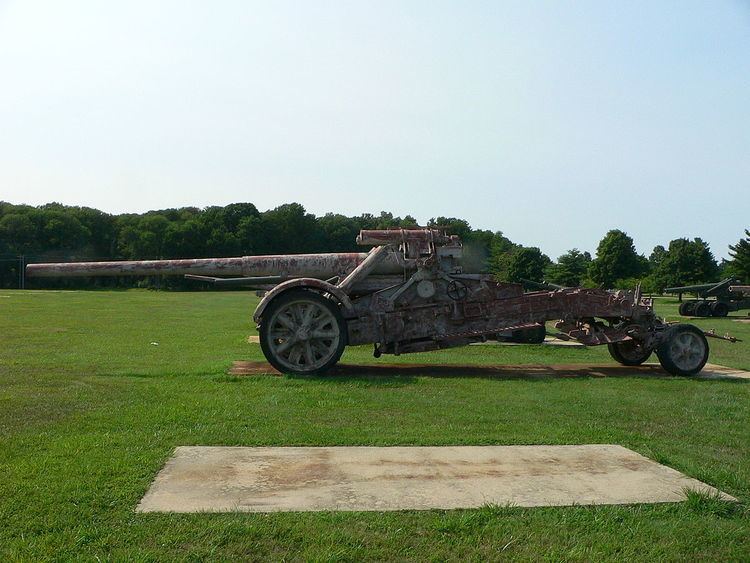Type Heavy gun In service 1941–45 | Used by Nazi Germany | |
 | ||
The 17 cm Kanone 18 in Mörserlafette (German: 17 cm Cannon 18 on Heavy Howitzer Carriage) (17 cm K 18 in MrsLaf) was a German heavy gun used in the Second World War.
Contents
History
In 1939 the 21 cm Mörser 18 began appearing in the German Army Corps level Artillery Regiments, replacing the obsolescent World War I-era 21 cm Mörser 16. The gun was able to send a 113 kg (249 lb) HE shell out to a range of 14.5 km (9.0 mi), however by 1941 the German Army was seeking a longer range weapon and Krupp responded by producing a smaller 173 mm caliber increased velocity weapon utilising the same carriage, which became the Kanone 18.
The Kanone 18 quickly impressed German Artillery officers, firing a 68 kg (149 lb) HE shell out to a range of 29.6 km (18.4 mi), the real surprise was the explosive power of the shell, which was little different from the 113 kg shell of the 21 cm Mörser 18. Production commenced in 1941, in 1942 production of the 21 cm Mörser 18 was halted for almost two years so as to allow maximum production of the Kanone 18.
Design
A remarkable innovation introduced by Krupp on the 21 cm Mörser 18 and used by the 17 cm Kanone 18 was the "double recoil" or dual- recoil carriage, the normal recoil forces were initially taken up by a conventional recoil mechanism close to the barrel, and then by a carriage sliding along rails set inside the travelling carriage. The dual-recoil mechanism absorbed all of the recoil energy with virtually no movement upon firing, thus making for a very accurate weapon. For all of its bulk, a full 360 degree traverse could be achieved by one man.
For travel both the 21 cm Mörser 18 and the 17 cm Kanone 18 were broken down into two loads, which was common for heavy artillery of the period, with the barrel being transported separately. The carriage was well equipped with a series of ramps and winches which made removing the barrel a reasonably quick task for its time, but still required several hours. For short distance travel the 17 cm Kanone 18 could be transported intact.
The 17 cm Kanone 18 was considered a technically excellent long range artillery piece for the German Army, its greatest weaknesses was that it was expensive to build, and it required careful maintenance. It was quite slow to bring in and out of action, fairly difficult to manoeuvre and very slow to move off road, many were lost when their crews abandoned them to avoid capture by advancing Allied forces.
Use
The 17 cm Kanone 18 was employed at the Corps level in order to provide long-range counter-battery support, as well as filling the same basic role as the 21 cm Mörser 18.
In 1944 some Allied batteries used captured 17 cm K 18s when ammunition supplies for their usual guns were disrupted by the long logistical chain from Normandy to the German border.
It was also proposed for use on the Sturmgeschütz Maus and Sturmgeschütz E-100 super heavy assault tanks. Nothing ever became of the proposal.
